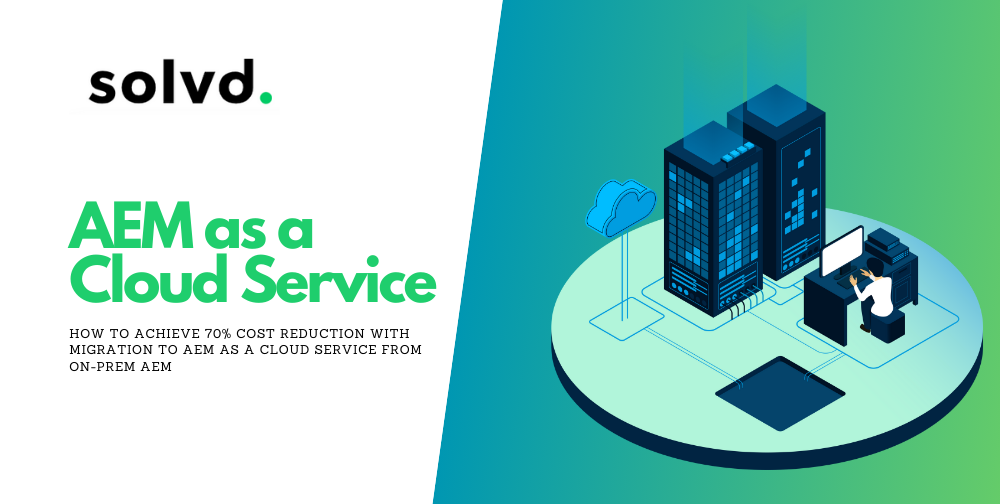How to Achieve 70% Cost Reduction with Migration to AEM as a Cloud Service from On-Prem AEM

Many organizations struggle with the high costs and maintenance burdens of on-premises (On-Prem) Adobe Experience Manager (AEM) solutions. AEM as a Cloud Service offers scalable, flexible, and altogether cost-effective solutions for content management. This article outlines a detailed migration plan to AEM as a Cloud Service, aiming for a substantial 70% cost reduction.
Global spending on cloud computing is predicted to reach $679 billion in 2024, $947.3 billion by 2026, and $1,266.4 billion by 2028, at a CAGR of 15.1% during the forecast period, according to the Cloud Computing Market Report (2023).
The top 10 global cloud providers in 2024 are expected to include Amazon Web Services (AWS), Microsoft Azure, Google Cloud Platform (GCP), Alibaba Cloud, Oracle Cloud, IBM Cloud, Tencent Cloud, OVHcloud, DigitalOcean, and Linode (owned by Akamai). AEM as a Cloud Service runs on Adobe infrastructure which is built using Microsoft Azure, providing services with an agreed SLA, and comes with a CDN by default.
What Companies Aim to Achieve by Migration to a Cloud Service
When companies migrate from On-Prem a Cloud Service, they typically want to hit the following key business targets:
- First and foremost: reduce maintenance overhead and have teams focused primarily on Product development
- Better content management capabilities.
- Increased flexibility: easier scaling of resources and quicker adaptation to market changes.
- Modernized tech stack.
- Consolidation of the multiple systems, meaning a unified platform for managing various digital assets and content types.
- Enhanced performance: a cloud service, for example, AEM on Cloud, typically provides improved speed, reliability, and responsiveness of digital experiences.
- Better compliance: streamlined processes for ensuring regulatory compliance and data security.
How On-Prem Works
On-Prem solutions involve hosting the software and data on local servers maintained by the organization. This setup maximizes control, while a cloud-based service provides convenience and scalability. On-Prem service presents several challenges:
- Higher maintenance costs than a cloud service.
- Having teams spend efforts on patches, security upgrades, etc.
- Limited scalability: scaling up involves substantial investments in hardware and software.
- Outdated technology: On-Prem systems often lag in adopting the latest innovations and security measures.
- You depend on human resources more than with a Cloud Service. And where there is a human there is a human factor risk.
Financial Burden of On-Prem AEM
The financial implications of maintaining an On-Prem AEM include:
- Maintenance costs: regular hardware and software maintenance, security updates, and troubleshooting.
- Licensing costs: periodic licensing fees for software and related services.
- Support costs: expenses related to technical support and system administration.
Key features of AEM as a Cloud Service include:
- Faster time to market for the product
- Better content management: you get advanced tools for creating, managing, and delivering content across various channels
- Well-balanced digital asset management
- Up-to-date tools for delivering personalized content experiences to users
Comparison with On-Prem AEM
Cloud services drastically reduce the need for upfront hardware investments and ongoing maintenance costs. It becomes easier to meet varying demands without significant investments in infrastructure. The new system can quickly adapt to new technologies and/or business requirements. Organizations can achieve up to 70% cost reduction by eliminating hardware costs, reducing maintenance and support expenses, and optimizing licensing fees simply by migrating to a cloud service from an on-prem one.
Cost of Migration to AEM as a Cloud Service
The migration to AEM as a Cloud Service involves several cost components:
- Licensing: fees for using AEM as a Cloud Service.
- Expenses related to setting up the cloud environment and configuring the system.
- Costs associated with training staff to use the new system effectively.
Benefits of Migration to AEM as a Cloud
As stated earlier, the benefits of moving to AEM as a Cloud Service are numerous. They include reduced maintenance costs, and cutting support costs by decreasing the need for in-house technical support. Infrastructure costs are also significantly reduced, with zero expenses on maintaining physical servers and data centers. The transition frees up office space and allows for faster workflow with fewer staff.
Not so long ago a multinational company got a 65% reduction in operational costs within the first year post-migration. It was mostly achieved by streamlining their content management and reducing reliance on physical infrastructure.
Step-by-Step Migration Plan
Phase 1: Assessment and Planning
Do the basics: evaluate your current on-prem infrastructure. Identify challenges and define migration goals. Establish clear objectives with specific timelines, budgets, and desired outcomes. Assemble a migration team. Include experts in migration architecture, cloud operations, and security.
Phase 2: Content Analysis and Migration Strategy
- Analyze existing content. Determine what needs to be migrated, archived, or decommissioned.
- Develop migration strategy: prioritize content and plan the process of relocating it. Start with the less important content.
- Select migration tools: choose the most appropriate for the migration.
Phase 3: Pilot Migration
This is one of the important tricks: do not try to move everything at once.
- Choose a small set of content for a pilot migration.
- See how it is going. Ensure data integrity and compatibility.
- Gather feedback.
- Correct mistakes..
Phase 4: Full-Scale Migration
Start with migrating non-critical content, it will reduce risk and allow you to test the migration process without impacting crucial operations. When you segment the migration into stages, it makes it easier to monitor each phase. And that’s what you need to do: constantly track progress, and identify issues (if any) in real time. As soon as a problem is identified, address it promptly.
Phase 5: Post-Migration Optimization
There are two key tasks to keep in mind after the migration: making sure users are happy and optimizing the system configuration. To accomplish the first one, provide comprehensive training for your team and clients to ensure they are comfortable with the new system. Offer user-friendly guides, video tutorials, or regular webinars to address common questions and issues. Create a support system: get a helpdesk or dedicated support team to assist users promptly.
To optimize the system’s configuration, use the Cloud Acceleration Manager (CAM) to monitor key performance indicators: response time, throughput, and error rates. Set up custom permissions via Cloud Manager to ensure only authorized personnel have access to sensitive data. Look after the scalability features of AEM as a Cloud Service. This includes auto-scaling resources during peak times and optimizing the use of CDN for better content delivery. Regularly check the content to remove outdated or duplicated items, for example with the Best Practice Analyzer (BPA) tool that helps identify these issues.
Keep your AEM instance updated with the latest patches released by the developer.
Phase 6: Measuring Success
This is the most pleasant part of your journey. You get to count the money you saved.
- Compare costs before and after migration.
- Assess the achievement of the initial targets: see how much cost reduction you’ve got.
- Collect testimonials: gather feedback from friendly organizations that successfully migrated and compare their results to yours.
- If deemed necessary, look for ways of further improvement and cost reduction.
Typical Problems When Migrating to AEM as a Cloud
As a company specializing in AEM migrations, we have identified common problems during the migration process:
Poor planning
Many organizations underestimate the complexity of their existing content structures and dependencies. This may lead to flawed migration strategies.
Not using right tools
Not using the right tools to migrate content and spending a lot of time migrating content and code is a typical problem. Ensuring content integrity and proper data mapping can be challenging. Loss of metadata and relationships between content items can disrupt content delivery and worsen user experience.
Excessive customization
Having too much customization from the OOTB features will also make the migration process tricky, as there will be a lot of functionalities to rewrite to support this migration. So the less customization, the better
Human factor
Effectively using AEM’s advanced features such as content fragments and dynamic media often requires rethinking content strategies and workflows. You need to retrain personnel used to the On-Prem systems.
Not providing enough cloud migration options
When, or if, you are a company that helps companies to migrate to AEM as a Cloud, it is important to offer various migration paths for different companies. Some organizations may prefer a phased approach, while others might opt for a big-bang migration. That being said, we recommend a phased approach as it is of the lower risk level.
The lack of experienced personnel to navigate the complexities of AEM migration can lead to oversights. Be sure to distribute detailed checklists to ensure a smooth process.
Case study: problems when migrating
One example of a problem encountered during such migration involved a large e-commerce company. It faced significant difficulties in maintaining the integrity of its extensive product catalog and user-generated content.
- Problem: The company had a vast amount of product data, including high-resolution images, detailed descriptions, user reviews, and ratings. Migrating this data while preserving its structure and relationships was critical for maintaining SEO rankings and user experience.
- But (there is always a “but”): Initial migration attempts resulted in broken links, missing images, and lost metadata. This led to decreased customer satisfaction with potential revenue loss.
- Solution: The migration team revisited their strategy and turned to the phased approach. They started by migrating non-critical content to test and refine their processes. They also developed custom scripts to ensure accurate data mapping and preservation of metadata. They built regular feedback loops and made adjustments that helped them gradually transition the entire product catalog without disruptions.
Conclusion
Migrating to AEM as a Cloud Service offers substantial benefits, including significant cost reductions, improved agility, and better digital experiences. To achieve a successful migration, you’d require careful planning, step-by-step execution, and post-migration optimization. By following a structured migration plan, companies can get a 70% reduction in costs. At the same time, they’d modernize their tech stack and improve their digital content management capabilities.
By Narendra Nandhyala, Director of Digital Experience at Solvd, Inc.





